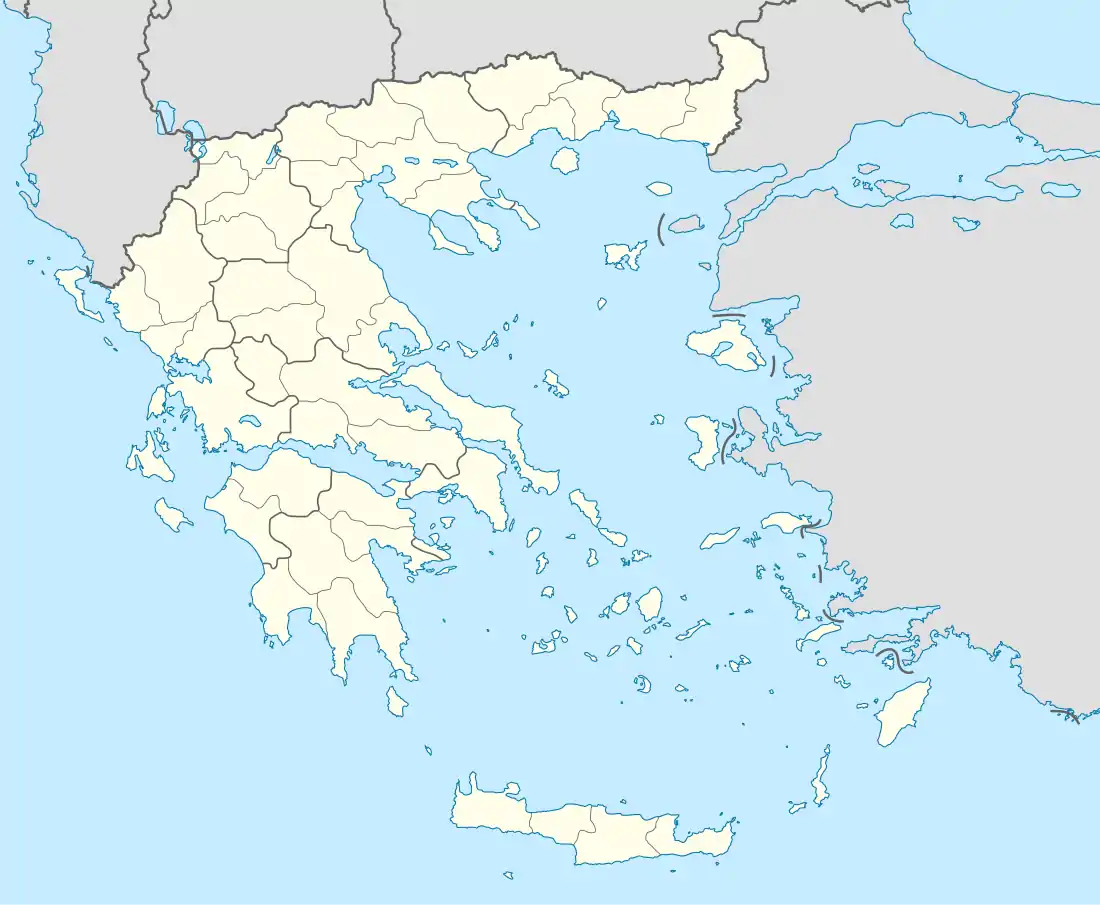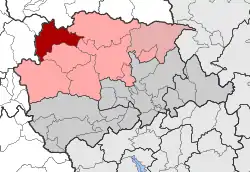Malakasi
Malakasi (Greek: Μαλακάσι) is a village and a former municipality in the Trikala regional unit, Thessaly, Greece. Since the 2011 local government reform it is part of the municipality Meteora, of which it is a municipal unit.[2] The municipal unit has an area of 157.534 km2.[3] Population 1,000 (2011). The seat of the municipality was in Panagia.
Malakasi
Μαλακάσι | |
|---|---|
 Malakasi Location within the regional unit  | |
| Coordinates: 39°48′N 21°20′E | |
| Country | Greece |
| Administrative region | Thessaly |
| Regional unit | Trikala |
| Municipality | Meteora |
| • Municipal unit | 157.5 km2 (60.8 sq mi) |
| Population (2011)[1] | |
| • Municipal unit | 1,000 |
| • Municipal unit density | 6.3/km2 (16/sq mi) |
| Community | |
| • Population | 138 (2011) |
| Time zone | UTC+2 (EET) |
| • Summer (DST) | UTC+3 (EEST) |
| Vehicle registration | ΤΚ |
Municipal unit
The municipal unit of Malakasi includes the settlements of Korydallos, Malakasi, Panagia, Pefki and Trygona.
History
The village takes its name from the Malakasioi, a Vlach tribe or clan that moved to the area from central Albania in the 14th century.[5]
Ottoman period
During the Ottoman period, Epirus and Aetolia-Acarnania were divided into five armatolikia: Malakasi, Tzoumerka, Xeromero, Lidorikion, and Venetiko.[6][7]
In May 1871, Malakasi was the seat of the Malakasi nahiye of the Ioannina kaza.[8]
Demographics
The village is inhabited by "Vlachs" (Βλαχι),[9] who are called Malakasi and inhabit the villages from Malakasi to Gardiki.[10]
References
- "Απογραφή Πληθυσμού - Κατοικιών 2011. ΜΟΝΙΜΟΣ Πληθυσμός" (in Greek). Hellenic Statistical Authority.
- Kallikratis law Greece Ministry of Interior (in Greek)
- "Population & housing census 2001 (incl. area and average elevation)" (PDF) (in Greek). National Statistical Service of Greece. Archived from the original (PDF) on 2015-09-21.
- Dionysios A. Zakythēnos (1976). The Making of Modern Greece: From Byzantium to Independence. Rowman and Littlefield. ISBN 978-0-87471-796-9.
- Nicholas Geoffrey Lemprière Hammond (1976). Migrations and invasions in Greece and adjacent areas. Noyes Press. pp. 39–42. ISBN 978-0-8155-5047-1.
- Apostolos Euangelou Vakalopoulos (1976). The Greek Nation, 1453-1669: The Cultural and Economic Background of Modern Greek Society. Rutgers University Press. ISBN 978-0-8135-0810-8.
- Миодраг Стојановић (1984). Хајдуци и клефти у народном песништву. Српска академија наука и уметности, Балканолошки институт. p. 41.
- Константин Леонтьев; Анатолий Васильевич Торкунов (2003). Дипломатические донесения, письма, записки, отчеты 1865-1872. РОССПЭН. p. 319.
- Tom Winnifrith (1987). The Vlachs: the history of a Balkan people. Duckworth. ISBN 978-0-7156-2135-6.
- Nicholas Geoffrey Lemprière Hammond (1967). Epirus: the Geography, the Ancient Remains, the History and Topography of Epirus and Adjacent Areas. Clarendon P.